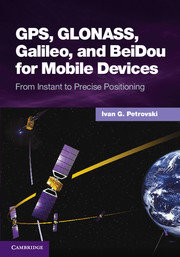Book contents
- Frontmatter
- Contents
- Foreword by Glen Gibbons
- About this book
- Acknowledgments
- List of abbreviations and acronyms
- List of definitions
- Part I GNSS: orbits, signals, and methods
- Part II From conventional to software GNSS receivers and back
- Part III Mobile positioning at present and in the future
- 8 Positioning with data link: from AGPS1 to RTK
- 9 Positioning without data link: from BGPS to PPP
- 10 Trends, opportunities, and prospects
- Part IV Testing mobile devices
- Index
- References
8 - Positioning with data link: from AGPS1 to RTK
from Part III - Mobile positioning at present and in the future
Published online by Cambridge University Press: 05 May 2014
- Frontmatter
- Contents
- Foreword by Glen Gibbons
- About this book
- Acknowledgments
- List of abbreviations and acronyms
- List of definitions
- Part I GNSS: orbits, signals, and methods
- Part II From conventional to software GNSS receivers and back
- Part III Mobile positioning at present and in the future
- 8 Positioning with data link: from AGPS1 to RTK
- 9 Positioning without data link: from BGPS to PPP
- 10 Trends, opportunities, and prospects
- Part IV Testing mobile devices
- Index
- References
Summary
Merging mobile and geodetic technologies
Positioning with data link is not the same as referenced positioning (a method that allows measurements from more than one receiver to be combined and processed together in order to enhance accuracy), which we have discussed in Chapter 4. In this chapter, we consider all possible external information that can be used to enhance receiver specification. This external information includes measurements from other receivers, but it also includes other information which can be used to improve not only accuracy, but also other parameters in the specification, such as TTFF and sensitivity.
It is very important for many applications to be able to provide instant positioning, i.e. to avoid the necessity of tracking a satellite signal and reading a navigation message. It takes up to 36 s to read a complete navigation message for a GPS L1 signal to ensure the decoding necessary for positioning data. If navigation message data are available through some other data link, it is still necessary to decode a time mark from the navigation message, which may require up to 6 s. BGPS (and AGPS before that) are very important for many applications because they allow instant positioning using just a snapshot of data.
- Type
- Chapter
- Information
- GPS, GLONASS, Galileo, and BeiDou for Mobile DevicesFrom Instant to Precise Positioning, pp. 207 - 237Publisher: Cambridge University PressPrint publication year: 2014



